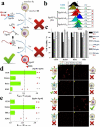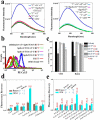DNA "nano-claw": logic-based autonomous cancer targeting and therapy
- PMID: 24367989
- PMCID: PMC3935767
- DOI: 10.1021/ja4114903
DNA "nano-claw": logic-based autonomous cancer targeting and therapy
Abstract
Cell types, both healthy and diseased, can be classified by inventories of their cell-surface markers. Programmable analysis of multiple markers would enable clinicians to develop a comprehensive disease profile, leading to more accurate diagnosis and intervention. As a first step to accomplish this, we have designed a DNA-based device, called "Nano-Claw". Combining the special structure-switching properties of DNA aptamers with toehold-mediated strand displacement reactions, this claw is capable of performing autonomous logic-based analysis of multiple cancer cell-surface markers and, in response, producing a diagnostic signal and/or targeted photodynamic therapy. We anticipate that this design can be widely applied in facilitating basic biomedical research, accurate disease diagnosis, and effective therapy.
Figures




Similar articles
-
Programmable and multiparameter DNA-based logic platform for cancer recognition and targeted therapy.J Am Chem Soc. 2015 Jan 21;137(2):667-74. doi: 10.1021/ja509263k. Epub 2014 Nov 25. J Am Chem Soc. 2015. PMID: 25361164 Free PMC article.
-
New insight into G-quadruplexes; diagnosis application in cancer.Anal Biochem. 2021 May 1;620:114149. doi: 10.1016/j.ab.2021.114149. Epub 2021 Feb 24. Anal Biochem. 2021. PMID: 33636157 Review.
-
Construction of a Multiple-Aptamer-Based DNA Logic Device on Live Cell Membranes via Associative Toehold Activation for Accurate Cancer Cell Identification.J Am Chem Soc. 2019 Aug 14;141(32):12738-12743. doi: 10.1021/jacs.9b05470. Epub 2019 Aug 1. J Am Chem Soc. 2019. PMID: 31328519
-
Antibody activation using DNA-based logic gates.Angew Chem Int Ed Engl. 2015 Feb 16;54(8):2530-3. doi: 10.1002/anie.201410779. Epub 2015 Jan 8. Angew Chem Int Ed Engl. 2015. PMID: 25573528
-
Rationally Designed Multivalent Aptamers Targeting Cell Surface for Biomedical Applications.ACS Appl Mater Interfaces. 2021 Mar 3;13(8):9369-9389. doi: 10.1021/acsami.0c15644. Epub 2020 Nov 4. ACS Appl Mater Interfaces. 2021. PMID: 33146988 Review.
Cited by
-
Biosensors with built-in biomolecular logic gates for practical applications.Biosensors (Basel). 2014 Aug 27;4(3):273-300. doi: 10.3390/bios4030273. eCollection 2014 Sep. Biosensors (Basel). 2014. PMID: 25587423 Free PMC article. Review.
-
Photoactivation of Ligands for Extrinsically and Intrinsically Triggered Disassembly of Amphiphilic Nanoassemblies.Chemistry. 2018 Feb 6;24(8):1789-1794. doi: 10.1002/chem.201705217. Epub 2018 Jan 16. Chemistry. 2018. PMID: 29314349 Free PMC article.
-
Biocomputing based on particle disassembly.Nat Nanotechnol. 2014 Sep;9(9):716-22. doi: 10.1038/nnano.2014.156. Epub 2014 Aug 17. Nat Nanotechnol. 2014. PMID: 25129073
-
Facile Assembly/Disassembly of DNA Nanostructures Anchored on Cell-Mimicking Giant Vesicles.J Am Chem Soc. 2017 Sep 13;139(36):12410-12413. doi: 10.1021/jacs.7b07485. Epub 2017 Aug 30. J Am Chem Soc. 2017. PMID: 28841373 Free PMC article.
-
Live cell PNA labelling enables erasable fluorescence imaging of membrane proteins.Nat Chem. 2021 Jan;13(1):15-23. doi: 10.1038/s41557-020-00584-z. Epub 2020 Dec 7. Nat Chem. 2021. PMID: 33288896
References
-
- Hollingsworth MA, Swanson BJ. Nat Rev Cancer. 2004;4:45. - PubMed
-
- Png KJ, Halberg N, Yoshida M, Tavazoie SF. Nature. 2012;481:190. - PubMed
-
- Ikeda A, Shankar DB, Watanabe M, Tamanoi F, Moore TB, Sakamoto KM. Mol Genet Metab. 2006;88:216. - PubMed
-
- Zhou H, Jiao P, Yang L, Li X, Yan B. J Am Chem Soc. 2011;133:680. - PubMed
-
- Kluza E, van der Schaft DW, Hautvast PA, Mulder WJ, Mayo KH, Griffioen AW, Strijkers GJ, Nicolay K. Nano Lett. 2010;10:52. - PubMed
Publication types
MeSH terms
Substances
Grants and funding
LinkOut - more resources
Full Text Sources
Other Literature Sources
Research Materials

